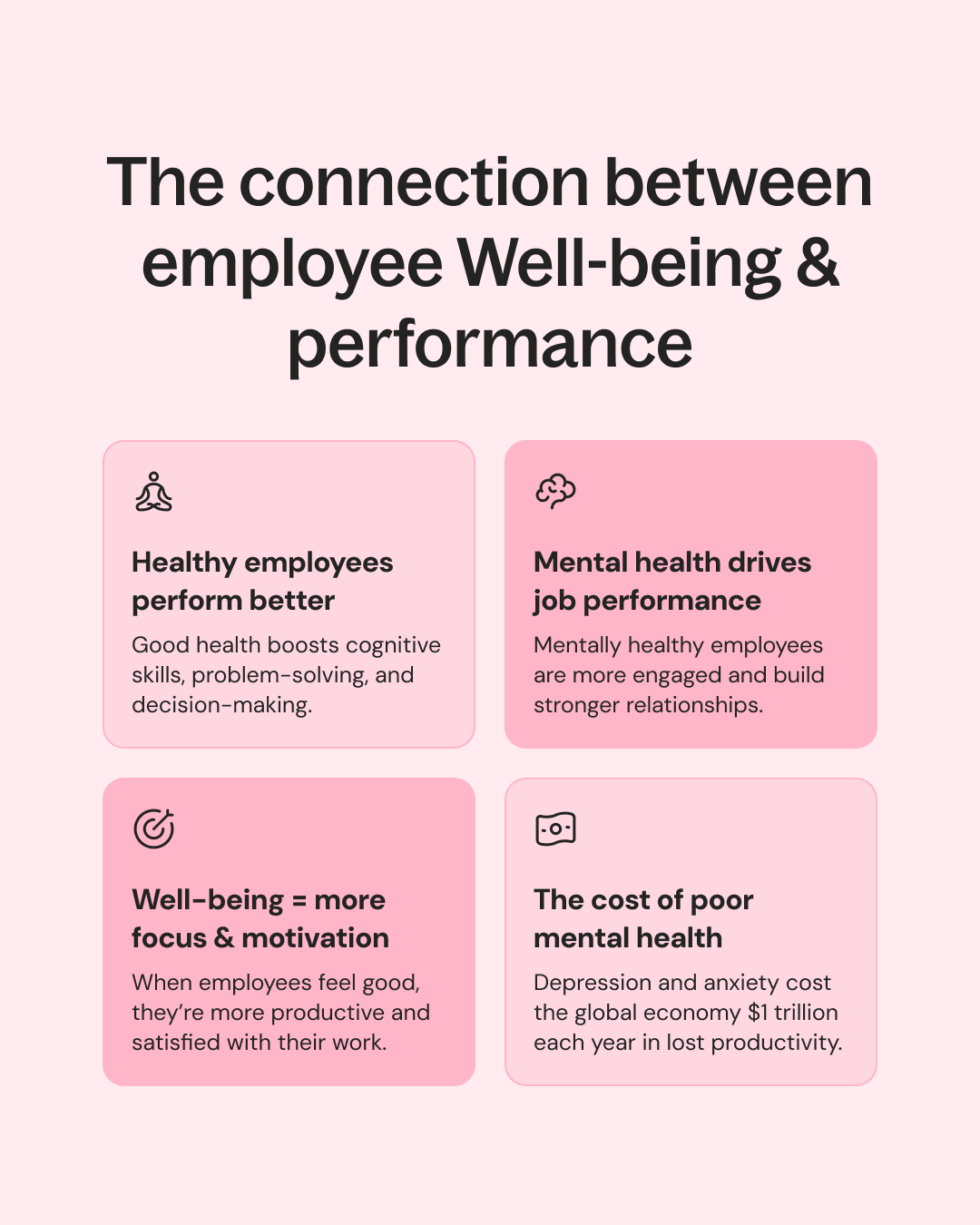10 Strategies to boost employee performance in the workplace
VIWELL team
Last updated January 21, 2025
VIWELL helps you elevate your workplace well-being.
In today’s evolving workplace landscape, an increasing number of employers are prioritizing health and well-being, with 72% placing greater emphasis on this aspect since the onset of COVID-19, according to the CIPD. This shift reflects a people-centric approach aimed at enhancing employee performance, productivity, and creativity within organizations, both large and small. While long-term investment in employee well-being undoubtedly pays dividends, it's essential to explore what can be done to boost productivity in the shorter term. Here are 10 strategies to boost employee performance in the workplace and nurture a more engaged workforce.
The connection between employee well-being and employee performance
The relationship between employee health and business performance is well-documented; good employee health enhances performance and vice versa. Research shows that good mental health improves cognitive flexibility and problem-solving abilities. A positive mental state fosters better interpersonal relationships, enabling effective support and knowledge sharing. As the American Psychological Association notes, "mental well-being is linked to improved job performance, as mentally healthy employees tend to be more engaged and better at building relationships at work."
When employees feel physically and mentally well, they are more engaged, motivated, and focused, leading to increased productivity and job satisfaction. The economic impact is significant; the World Health Organization estimates that depression and anxiety cost the global economy $1 trillion in lost productivity annually. By addressing mental health concerns and promoting a healthy work environment, companies can mitigate these losses and enhance their bottom line.
Here are 10 Strategies to boost employee performance in the workplace:
Nurture better relationships
Strong relationships and collaboration are key drivers of performance across the organization. Create opportunities for departments and individuals to build closer bonds by organizing events like desk yoga, team building events or office gatherings. When employees connect as friends, not just colleagues, they are more likely to contribute positively to the workplace.
Consider the environment
The workplace environment significantly impacts mood and productivity. According to the Global Workspace Explorer study, 42% of employees claim that poor office design negatively impacts their mental health. Assess and enhance your office design by incorporating bright colors and good lighting, while ensuring safety by using quality equipment. Well-designed office spaces can also boost productivity significantly.
Communicate more clearly to boost employee performance
Effective communication is the backbone of a high-functioning workforce. Implement regular department feedback sessions, town hall meetings, and internal newsletters to share the company’s vision and invite employee input. A report by McKinsey shows that effective communication can boost team productivity by 20 to 25%. When employees feel informed and valued, their engagement and performance improve.
Have some fun!
Laughter and fun can significantly boost office morale. Engage employees in exciting and light-hearted activities, such as team-building games or friendly competitions. This not only fosters stronger relationships but also enhances team spirit, creating a more vibrant and connected environment.
Start prioritizing employee wellness
Making employee wellbeing a priority can have a profound impact on performance. Implement wellness programs that focus on mental and physical health, such as fitness challenges or stress management workshops. According to the World Health Organization, depression and anxiety cost the global economy approximately $1 trillion in lost productivity each year. By actively promoting health and wellness, organizations can create a happier, more engaged workforce that is not only more productive but also more creative and innovative.
Set clear goals and expectations
Work with management to establish SMART (Specific, Measurable, Achievable, Relevant, Time-bound) goals for teams and individuals. Clear expectations help employees understand their roles and how they contribute to the organization’s success.
Provide development opportunities
Invest in tailored training programs and career development resources for employees. Supporting continuous learning not only enhances skills but also increases employee retention and engagement.
Recognize and reward achievements
Develop a structured recognition program that acknowledges individual and team accomplishments regularly. Recognition boosts morale and motivates employees to perform at their best.
Empower employees
Encourage autonomy in decision-making and ownership of tasks by delegating authority where appropriate. Empowered employees are more motivated and innovative, driving performance improvements.
Leverage technology
Implement performance management tools that facilitate real-time feedback and track employee progress. Technology can streamline performance evaluation processes and enhance employee engagement through continuous communication.
Enhance employee well-being with the VIWELL ecosystem
By implementing effective strategies, organizations can create a healthier, more productive work environment that enhances overall performance and drives business success. To support these efforts, consider the VIWELL Ecosystem—an all-in-one solution designed to unlock the full potential of your workforce. With the Employer Dashboard, you can track employee well-being and engagement in real-time, gaining actionable insights to drive success. The Employee App empowers your workforce by boosting productivity and enhancing personal wellness, while our Engagement Tools & Resources allow you to design and manage impactful well-being programs that keep your team educated, engaged, and thriving. Try the VIWELL Ecosystem today to elevate employee engagement and performance!
FAQ’s
-
Strong employee relations enhance trust and collaboration, leading to increased engagement and productivity. Positive relationships can reduce turnover and improve overall team dynamics.
-
A good work-life balance minimizes stress and burnout, promoting better mental and physical health. Employees with balanced lives tend to be more satisfied and productive, which benefits the organization.
-
Use employee surveys, performance metrics, and engagement scores to assess the impact of your initiatives. Regular check-ins can help you adjust strategies as needed.



